advertisement

Abstract #116851 Published in IGR 24-4
Association of Psychosocial Factors with Activation Among Patients with Glaucoma
Morse AR; Hark LA; Gorroochurn P; Rojas R; Seiple WH; Shukla AG; Shukla AG; Wang Y; Maruri SC; Henriquez DR; Harizman N; Wang Q; Liebmann JM; Cioffi GAOphthalmology. Glaucoma 2024; 7: 410-417
OBJECTIVE: To investigate the association of psychosocial factors with health self-management behaviors and beliefs among patients with primary open-angle glaucoma (POAG). DESIGN: Prospective cross-sectional cohort study. PARTICIPANTS: Patients (n = 202) with mild, moderate, or advanced bilateral POAG. METHODS: Patients (N = 1164) were identified from electronic medical records at a single academic medical center. Letters soliciting participation were mailed to 591 randomly selected potential participants. Psychometric measures and a social determinants of health questionnaire were administered by phone to 202 study participants. MAIN OUTCOME MEASURES: The National Eye Institute Visual Function Questionnaire-8 (NEI-VFQ), the Multidimensional Health Locus of Control (MHLC), the Perceived Medical Condition Self-Management Scale-4, the Patient Health Questionnaire-9 (PHQ), the Patient Activation Measure-13 (PAM), a health literacy question, and a social determinants of health questionnaire. RESULTS: For each increase in level of POAG severity, there was a decrease in mean NEI-VFQ score (P < 0.001). For each unit increase in NEI-VFQ item 1, self-rated vision, mean PAM score increased (R = 5.3%; P = 0.001; 95% confidence interval [CI], 0.077-0.276). For each unit increase in "Internal" on the MHLC, mean PAM score increased (R = 19.3%; 95% CI, 0.649-1.166; P < 0.001). For each unit increase in "Doctors" on the MHLC, mean PAM score increased (R = 11.0%; 95% CI, 1.555-3.606; P < 0.001). For each unit increase in "Chance" on the MHLC, mean PAM score decreased (R = 2.6%; 95% CI, -0.664 to -0.051; P = 0.023). On multivariate analysis, adjusting for age, sex and race, for each unit increase in PHQ, mean PAM score decreased (95% CI, 0.061-1.35; P = 0.032); for each unit increase in MHLC "Doctors", mean PAM score increased (95% CI, -1.448 to 3.453; P < 0.001); for each unit increase in MHLC "Internal", mean PAM score increased (95% CI, 0.639-1.137; P < 0.001); for each unit increase in MHLC "Chance", mean PAM score decreased (95% CI, -0.685 to -0.098; P = 0.009). CONCLUSIONS: We identified modifiable behavioral factors that could increase patients' self-perceived ability and confidence to manage their own eye care. Locus of control (MHLC), level of depression (PHQ), and self-rated functional vision (NEI-VFQ) were each associated with patient behaviors, attitudes, and beliefs needed for health self-management (activation, assessed by the PAM) and may be important determinants of adherence behaviors. Targeting change in patients' care beliefs and behaviors may improve activation and treatment outcomes. FINANCIAL DISCLOSURE(S): Proprietary or commercial disclosure may be found in the Footnotes and Disclosures at the end of this article.
Edward S. Harkness Eye Institute, Department of Ophthalmology, Columbia University Irving Medical Center, New York, New York. Electronic address: am2955@cumc.columbia.edu.
Full article
